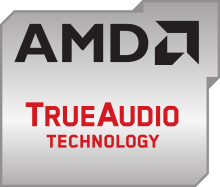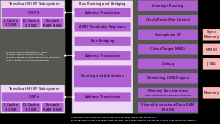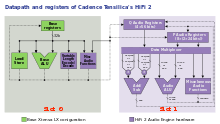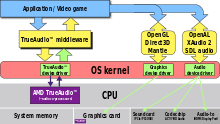AMD TrueAudio
 | |
| Design firm | Advanced Micro Devices |
|---|---|
| Introduced | October 2013 |
| Type | audio acceleration |


TrueAudio is the name given to AMD's ASIC intended to serve as dedicated co-processor for the calculations of computationally expensive advanced audio effects, like e.g. convolution reverberation effects and 3D audio effects. TrueAudio is integrated into some of the AMD GPUs and APUs available since 2013.
Overview
TrueAudio is a DSP for audio based on Cadence Tensilica HiFi EP DSP with Tensilica Xtensa SP Fload support.[1]
AMD claimed, that a few simple audio effects can use up to 14% of the CPU, Audiokinetic claim up to 10%.[2] Independent software vendors (ISV), such as game developers, can use what is called a Wwise audio plugin to offload such computations to the TrueAudio DSPs. The on-die TrueAudio DSPs provide a better "silicon area to computing power" ratio and "power consumption to computing power" ratio for audio processing than the CPU, effectively making it an audio acceleration unit. Any additional benefits of the TrueAudio DSPs, such as "better effects", have been severely criticized.[3]
The possibility to include multiple TrueAudio DSPs on a die speak for the to be expected acceleration benefits. And in case latency is important, the on-die TrueAudio DSPs should have a much lower latency than a discrete sound card on the PCI bus. Given that VR Head-mounted displays, such as the Oculus Rift, do require more computing power due to the necessity to deliver a frame rate of at least 75 FPS and the probable utilization of high display resolutions in the future, offloading any suitable calculations to highly specialized SIP blocks or chips makes sense.
It may be noteworthy that Unified Video Decoder is another ASIC by AMD which is also based on Tensilica's Xtensa, and that Tensilica is member of the HSA Foundation.
In 18 March 2014 AnandTech evaluated AMD TrueAudio using the Thief video game.[4]
Software support


AMD TrueAudio enables dedicated digital signal processing (DSP). Such dedicated audio processing horsepower is specifically for generating immersive soundscapes and saves CPU cycles that can be used for other game processing tasks such as AI and Physics.
The video games Murdered: Soul Suspect, Star Citizen, Thief and Lichdom: Battlemage (uses CryEngine) can be configured to use AMD TrueAudio if present.
There is an audio plug-in for Audiokinetic's Wwise (Wave Works Interactive Sound Engine) to off-load computation to the TrueAudio DSP(s). Wwise is available for Linux, OS X, Windows, PlayStation 4, Xbox One et al.
GenAudio's AstoundSound, a highly optimized collection of advanced DSP C/C++ software available as a library or a plugin for augmenting real-time audio engines on Linux, OS X, Windows as well as Android and iOS, can make use of AMD TrueAudio.[5] AstoundSound is also wrapped for several plug-in formats, such as RTAS and Wwise and has been integrated into several DSP chips. AstoundSound is described as fully programmable audio engine.[6][7] As of July 2014 there are no news regarding products supporting TrueAudio and LV2.
- Tuscany AstoundSound on YouTube – special version of "Tuscany" VR demo from Oculus VR; AMD TrueAudio is utilized to calculate the spatialization of an audio environment. Spatialization is a technique that permits the audio engine to create a fully 3D soundfield on a stereo headset. This effect is powered by the positional 3D audio plugin "AstoundSound 3D RTI" (real-time interface) by GenAudio, and it includes support for elevation, distance and positioning. AstoundSound is e.g. integrated with the FMOD Studio.
Availability
AMD TrueAudio is found on-die of select AMD graphics cards and APUs. A die can house multiple AMD TrueAudio DSP cores, each having 32KiB instruction and data caches and 8KiB of scratchpad memory for local operation.[8]
Feature overview for AMD graphics cards
AMD TrueAudio SIP blocks are found on the dies of some GPUs of the AMD Radeon Rx 200 Series,[9] namely the Radeon R7 260, Radeon R7 260X, Radeon R9 285, Radeon R9 290, Radeon R9 290X and the Radeon R9 295X2. AMD TrueAudio is found in the PlayStation 4.
Feature overview for AMD APUs
| Brand | Brazos (low power) | Llano | Trinity | Richland | Kabini & Temash (low power) | Kaveri | Beema & Mullins (low power) | Carrizo | Carrizo-L (low power) |
|---|---|---|---|---|---|---|---|---|---|
| Released | Jan 2011 | Aug 2011 | Oct 2012 | 2013 | May 2013 | Jan 2014 | Q2 2014 | 2015 | 2015 |
| Fab (nm) | TSMC 40 nm | GlobalFoundries 32 nm SOI | 28 | 28 | 28 | 28 | 28 | ||
| APU Socket | FT1 | FM1 FS1 | FM2 FS1+ FP2 | AM1 FT3 | FM2+ FP3 | FT3b | TBA | TBA | |
| CPU cores | Bobcat | AMD 10h | Piledriver | Jaguar | Steamroller | Puma | Excavator | Puma+[10] | |
| 3D engine1 | 80:8:4 | 400:20:8 | 384:24:6 | 384:24:6 | 128:8:4 | 512:32:8 | 128:8:4 | TBA | TBA |
| TeraScale 2 (VLIW5) | TeraScale 3 (VLIW4) | Graphics Core Next (Mantle, HSA) | |||||||
| IOMMUv1 | IOMMUv2 | IOMMUv1[11] | TBA | TBA | |||||
| Unified Video Decoder | UVD 3 | UVD 4 | UVD 4.2 | TBA | TBA | ||||
| Video Codec Engine | N/A | VCE 1.0 | VCE 2.0 | TBA | TBA | ||||
| TrueAudio | N/A | Yes[12] | N/A[11] | TBA | TBA | ||||
| Max. № of displays2 | 2 | 2–3 | 2–4 | 2 | 2–4 | 2 | TBA | TBA | |
| Direct Rendering Manager/ Mesa 3D driver[13][14] |
Yes[14] | WiP[15] | WiP[16] | ||||||
- 1 Unified shaders : Texture mapping units : Render output units
- 2 To feed more than two displays, the additional panels must have native DisplayPort support.[17] Alternatively active DisplayPort-to-DVI/HDMI/VGA adapters can be employed
AMD TrueAudio SIP blocks are found on the die of "Kaveri" desktop APUs and Kaveri" mobile APUs.[9]
See also
- Advanced Linux Sound Architecture – Linux kernel sound subsystem
- E-mu 20K – chip soldered on Sound Blaster X-Fi sound cards
- SoundStorm – Nvidia technology in nForce chipsets
- Aureal Vortex – dedicated chip for computation of audio effects
- C-Media – Taiwanese designer of sound chips
- VIA Envy
- Yamaha DSP-1
- FMOD – middleware for audio
Other AMD SIP blocks
References
- ↑ "Everything You Wanted to Know About AMD TrueAudio". Maximum PC. 2013-10-08. Retrieved 2014-07-06.
- ↑ "Wwise Convolution Reverb with TrueAudio". 2013-11-21.
- ↑ "Do We Really Need AMD TrueAudio?". 2013-09-26. Retrieved 2014-07-06.
- ↑ "Evaluating AMD's TrueAudio and Mantle Technologies with Thief". AnandTech. 2014-03-18. Retrieved 2014-07-06.
- ↑ "AstoundSound for Gaming". 2013-11-21.
- ↑ "AstoundSound – 3D-Audio-Demo by Genaudio" (in German).
- ↑ "AstoundSound Homepage".
- ↑ "AMD A8-7600 Kaveri APU review - The Embedded GPU - HSA & hUMA". 2014-01-14.
- ↑ 9.0 9.1 "A technical look at AMD’s Kaveri architecture". SemiAccurate. 2014-01-15.
- ↑ "AMD Mobile “Carrizo” Family of APUs Designed to Deliver Significant Leap in Performance, Energy Efficiency in 2015" (Press release). 2014-11-20. Retrieved 2015-02-16.
- ↑ 11.0 11.1 Thomas De Maesschalck (2013-11-14). "AMD teases Mullins and Beema tablet/convertibles APU". Retrieved 2015-02-24.
- ↑ "A technical look at AMD’s Kaveri architecture". Semi Accurate. Retrieved 6 July 2014.
- ↑ Airlie, David (2009-11-26). "DisplayPort supported by KMS driver mainlined into Linux kernel 2.6.33". Retrieved 2014-07-02.
- ↑ 14.0 14.1 "Radeon feature matrix". freedesktop.org. Retrieved 2015-02-13.
- ↑ "AMDKFD Driver Does More Prepping For Carrizo / VI APUs". 2015-01-13. Retrieved 2015-01-13.
- ↑ "AMDKFD Driver Does More Prepping For Carrizo / VI APUs". 2015-01-13. Retrieved 2015-01-13.
- ↑ "How do I connect three or More Monitors to an AMD Radeon™ HD 5000, HD 6000, and HD 7000 Series Graphics Card?". AMD. Retrieved 2014-12-08.
External links
| ||||||||||||||||||||||||||||||||||||||||||||||||||||||||||||||
| ||||||||||||||||||||||||||||||||||||||||||||